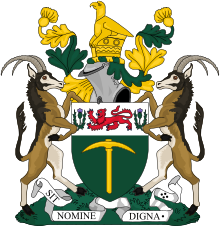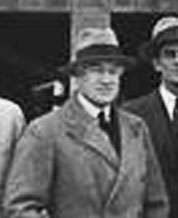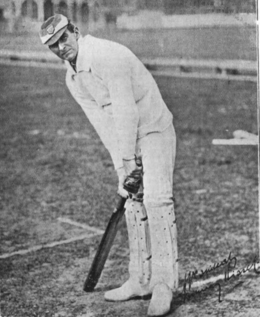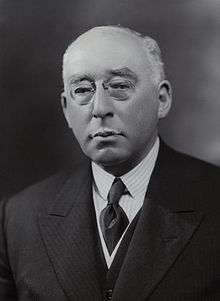Governor of Southern Rhodesia
The Governor of Southern Rhodesia was the representative of the British monarch in the self-governing colony of Southern Rhodesia from 1923 to 1980. The Governor was appointed by The Crown and acted as the local head of state, receiving instructions from the British Government.
| Governor of Southern Rhodesia | |
|---|---|
.svg.png) Flag of the Governor of Southern Rhodesia (1952–1980) | |
| Style | His Excellency The Right Honourable |
| Residence | Government House, Salisbury |
| Appointer | King/Queen of the United Kingdom |
| Formation | 1 October 1923 |
| First holder | The Rt Hon. John Chancellor |
| Final holder | The Lord Soames |
| Abolished | 18 April 1980 |
 |
|---|
| This article is part of a series on the politics and government of Rhodesia |
|
Constitutional history
|
|
Government |
|
Legislature
|
|
Foreign relations |
|
National symbols |
Constitutional role
The Governor was also Commander-in-Chief of the armed forces and as such, in theory at least, exercised considerable influence over the running of the colony and its government, but in practice, the Governor's main function was to maintain a satisfactory relationship between the British and Southern Rhodesian Governments and acted in an advisory capacity most of the time. From 1951, however, in contrast to other colonies, the British government was represented in Southern Rhodesia by a High Commissioner in Salisbury.[1]
When Southern Rhodesia was part of the Federation of Rhodesia and Nyasaland, the position of the Governor remained unchanged, but as Salisbury became the capital of the Federation, the Governor General resided at Government House, previously the Governor's official residence.[2] During this time, the Governor of Southern Rhodesia resided at Governor's Lodge in the suburb of Highlands.[3]
UDI
Following the Unilateral Declaration of Independence in 1965, the government of Ian Smith ceased to recognise the authority of the then Governor, Sir Humphrey Gibbs, and appointed Clifford Dupont to exercise the Governor's powers as Officer Administering the Government.[4]
However, Gibbs continued to occupy Government House, asserting his position as the Queen's de jure representative, and did not resign from the post until June 1969, following the decision of white voters in a referendum to approve a new constitution declaring Rhodesia, as Southern Rhodesia had become more commonly known, a republic.[5]
In 1977, Field Marshal The Lord Carver was designated Resident Commissioner for Rhodesia, but he resigned fourteen months later.[6]
The office of Governor remained vacant until 11 December 1979, when Lord Soames assumed the post, following the signing of the Lancaster House Agreement, under which Southern Rhodesia would achieve de jure independence as Zimbabwe on 18 April 1980.
Flag
.svg.png)
.svg.png)
.svg.png)
In common with most other British colonies, the flag used by the Governor, as the Sovereign's representative in Southern Rhodesia was initially a Union Flag with a white roundel in the centre, charged with the shield from the colony's arms granted on 11 August 1924. Unique among the flags of the Governors of British Colonies, this shield of Arms was not surrounded by the customary wreath. This flag was adopted on 1 October 1924 and was flown until 30 July 1951.
On 31 July 1951, a new flag was put into use for the Governor of Southern Rhodesia. This was dark blue and charged in the centre with a Royal Crown, its height being four-sevenths of the hoist. Initially the Tudor Crown would have been used, but after her accession to the throne in 1952, Queen Elizabeth II indicated her preference for St Edward's Crown and this version would have been used thereafter. Although the colony had attained 'Responsible Government' in 1923, it was never a fully fledged Dominion, and so did not have a Governor-General, whose flag in other Dominions would be dark blue, charged in the centre with the Royal Crest above a Crown, with the name of the Dominion written in a yellow scroll below.
Governors of Southern Rhodesia (1923–1980)
| Took office | Left office | Portrait | Name (Birth–Death) |
Comments |
|---|---|---|---|---|
| 1 October 1923 | 15 June 1928 |  |
Sir John Chancellor (1870–1952) |
|
| 15 June 1928 | 24 November 1928 |  |
Sir Murray Bisset (1876–1931) |
Acting |
| 24 November 1928 | 1 May 1934 |  |
Sir Cecil Hunter-Rodwell (1874–1953) |
|
| 1 May 1934 | 8 January 1935 |  |
Sir Fraser Russell (1876–1952) |
Acting; 1st Time |
| 8 January 1935 | 8 January 1942 |  |
Sir Herbert Stanley (1872–1955) |
|
| 8 January 1942 | 10 December 1942 |  |
Sir Fraser Russell (1876–1952) |
Acting; 2nd Time |
| 10 December 1942 | 26 October 1944 |  |
Sir Evelyn Baring (1903–1973) |
|
| 26 October 1944 | 20 February 1945 |  |
Sir Robert James Hudson (1885–1963) |
Acting; 1st Time |
| 20 February 1945 | 2 February 1946 |  |
Sir Campbell Tait (1886–1946) |
|
| 2 February 1946 | 19 July 1946 |  |
Sir Fraser Russell (1876–1952) |
Acting; 3rd Time |
| 19 July 1946 | 14 January 1947 |  |
Sir Robert James Hudson (1885–1963) |
Acting; 2nd Time |
| 14 January 1947 | 21 November 1953 |  |
Sir John Noble Kennedy (1893–1970) |
|
| 21 November 1953 | 26 November 1954 |  |
Sir Robert Clarkson Tredgold (1899–1977) |
Acting |
| 26 November 1954 | 28 December 1959 |  |
Sir Peveril William-Powlett (1898–1985) |
|
| 28 December 1959 | 24 June 1969 |  |
Sir Humphrey Gibbs (1902–1990) |
After the UDI on 11 November 1965, position not recognized by the Rhodesian government |
| 24 June 1969 | 11 December 1979 | Position vacant | On 1 September 1977, Field Marshal The Lord Carver was named as Resident Commissioner-designate | |
| 11 December 1979 | 18 April 1980 | .jpg) |
The Lord Soames (1920–1987) |
For continuation after independence, see: President of Zimbabwe
See also
References
- Diplomacy with a Difference: the Commonwealth Office of High Commissioner, 1880–2006, Lorna Lloyd, BRILL, 2007, page 240
- Federation of Rhodesia and Nyasaland Newsletter, Issues 27-52,, 1960, page 428
- Year Book and Guide of the Rhodesias and Nyasaland, with Biographies, Rhodesian Publications, Limited, 1962, page 33
- Ian Smith Strips Gibbs Of All Official Privilege, Associated Press, The Morning Record, November 18, 1965
- Final Break, TIME, June 27, 1969
- Obituary: Field Marshal Lord Carver, The Guardian, 12 December 2001
.svg.png)